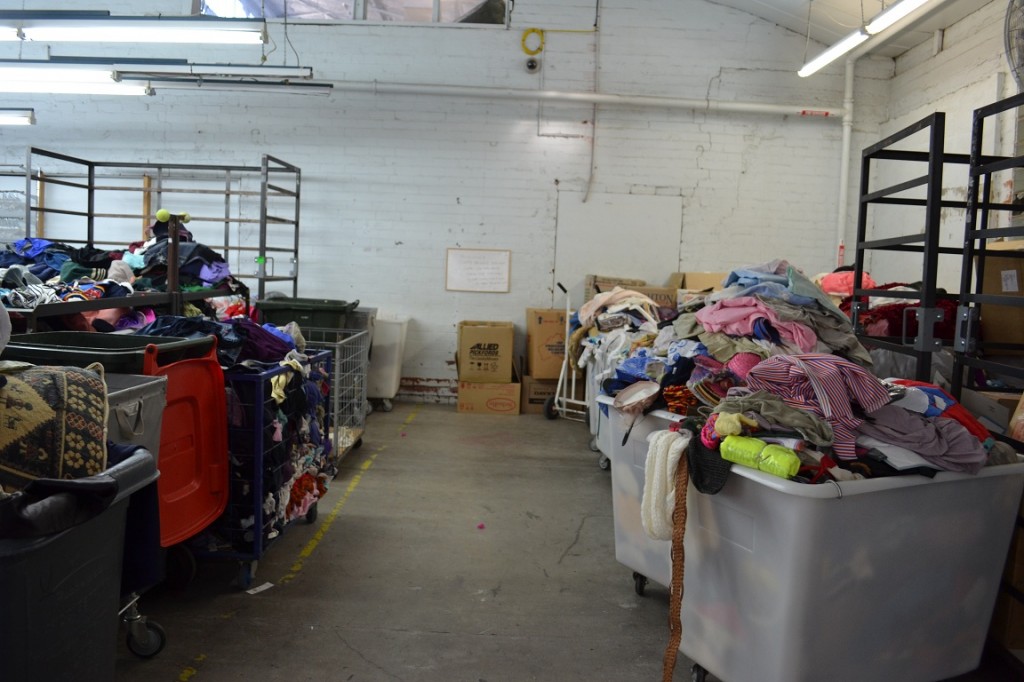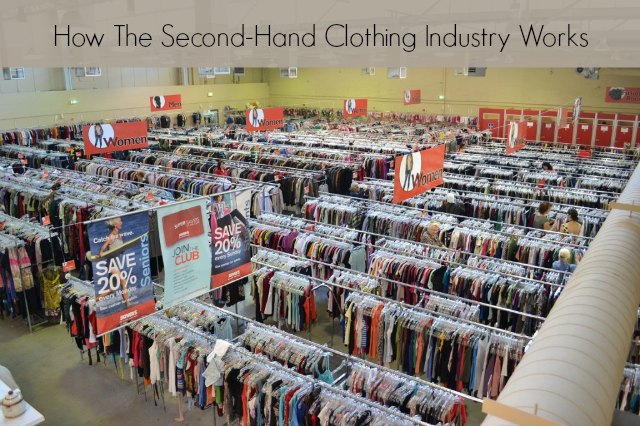I have the pleasure of being able to share with readers today an exciting 2012 ‘Thrifty Thursday’ partnership Miscellaneous Mum has made with Savers Australia – The Recycle Superstore. Over the duration of the year I will be occasionally posting about the internationally renowned recycled clothing and homewares store and discussing in a wider sense the benefits and surprises of buying second-hand goods. To start I had a rare treat of a store tour last week: Donna McMaster, Managing Director of Savers Australia, took me around the Brunswick store to give me a behind-the-scenes look at how this busy store operates and the processes involved, as well as letting me know a little of the company’s philanthropic philosophy. If you’ve ever been curious about ‘how things work’, then you’re about to find out!
How Does the Process Begin?
“The recycled clothing journey begins at Saver’s when the truck of donations arrives at the back door,” says Donna. “These goods are then taken off and separated into two major groups: cloth and ‘hard goods’. This product is then weighed, which triggers the commercial payment that is then given to the charity that is delivering it. This payment must always exceed their cost of operations by a minimum of twenty per cent to make it worth their while. They then pack up and leave and we are left to begin the job of sorting.” That seemed like a pretty big gamble to me, so I had to ask the question, “You don’t even know what you’re getting?” Donna nodded. “That’s right – every single delivery is a lottery. A very exciting one! As we pay on weight, we have literally no idea what’s arrived until we go through it and look at each piece individually.” This is how that happens.
Clothes and cloth
Are bundled onto carts and taken to the sorting tables to be separated into sellable and non-sellable piles. Donna explained that approximately 60% of all donated goods are deemed non-sellable and these are put back onto the cart. Those that have been deemed to be in good condition are hung up in rows according to their category (women, men, kids) to be thoroughly assessed before ascertaining a retail price. This assessment includes asking such questions as: What is the condition? Are there rips? Sagging hems? Stains? What is the brand? Is it high quality? What is the fabric?


Once a price has been determined the item is ticketed and racked, ready to go out on the floor. Donna says, “The average price of a piece of clothing is around the $5.50-$6.00 mark. We get the occasional complaint that something might be questionably high in value, or there are two exact items side by side with different prices. To that I say, at the Brunswick store alone, we ticket 6,000 items per day, 6 days a week, 1 garment at a time. So we apologise and say we do do our best, but the odd mistake happens. We are currently looking into rating software that will take that variable factor away.’

What happens to the non-sellable clothes?
These get taken to the bailing machine to be bailed up and shipped to underdeveloped nations, as are all clothes that remain on the floor for longer than a few weeks. “We figure if it hasn’t sold in that time, given the high customer rate (8-10 thousand per week in Brunswick alone) and turnover, then it probably won’t sell,” says Donna. “This way the clothes are kept out of landfill and will help others. Sometimes cloth will go to rag buyers, or we will dispose of it responsibly.”


Furniture, Electrical and Other Goods

Homeware section

Books area – heaven!

Shoe sorting area
Savers Shopping Tips
While I was there I discovered that the new product brought out onto the floor is hung on the left hand side of the bars, between dividers. So if you’re looking for new things, start at the left. There is also a five week colour tag rotation, so by looking at the tag and its position on the rung you can determine how long a garment has been around. Are there any times that are better to shop than others? In terms of stock, no, says Donna. “It’s constantly changing. We have people come in several days a week. Our customers can be broken down into three major groups: one-third are low to middle class purchasers, one-third are eBay resellers and antique dealers, and the last third are alternative fashion crowd, many young students, who like to do their own thing and not follow the current trends and fads.” There is also a 14 day return policy; all that is needed for this is the proof of purchase (receipt) and intact tags.
Savers and the Community
“There is a lot of waste,’ Donna admits, “and there are some out there who treat donation points like they were hard rubbish dumping sites, but people generally do the right thing. And the responsibility is then ours to dispose of it.” But there is a positive side too. ‘Our business model is to give back to the community and that often means saving up to open a new store, thus providing local employment and an alternative to keep things out of landfill. That’s always a good thing, and I don’t think we’re touching the surface yet of what we could still do and achieve,’ says Donna. “We have strategic partnerships with three major charities, two from this state – Diabetes Australia Victoria and SIDS and Kids Victoria – and in South Australia, Diabetes South Australia. Diabetes Australia Victoria’s net profit alone is over one million dollars per year, coming from their soliciting donations by various means, including leaving bags and magnets and through their call centre: if you call the number, a truck can come and pick up your goods from your home.”
I’d like to thank Donna for taking the time to show me around and I hope you all found this little virtual tour as interesting as I did.



















